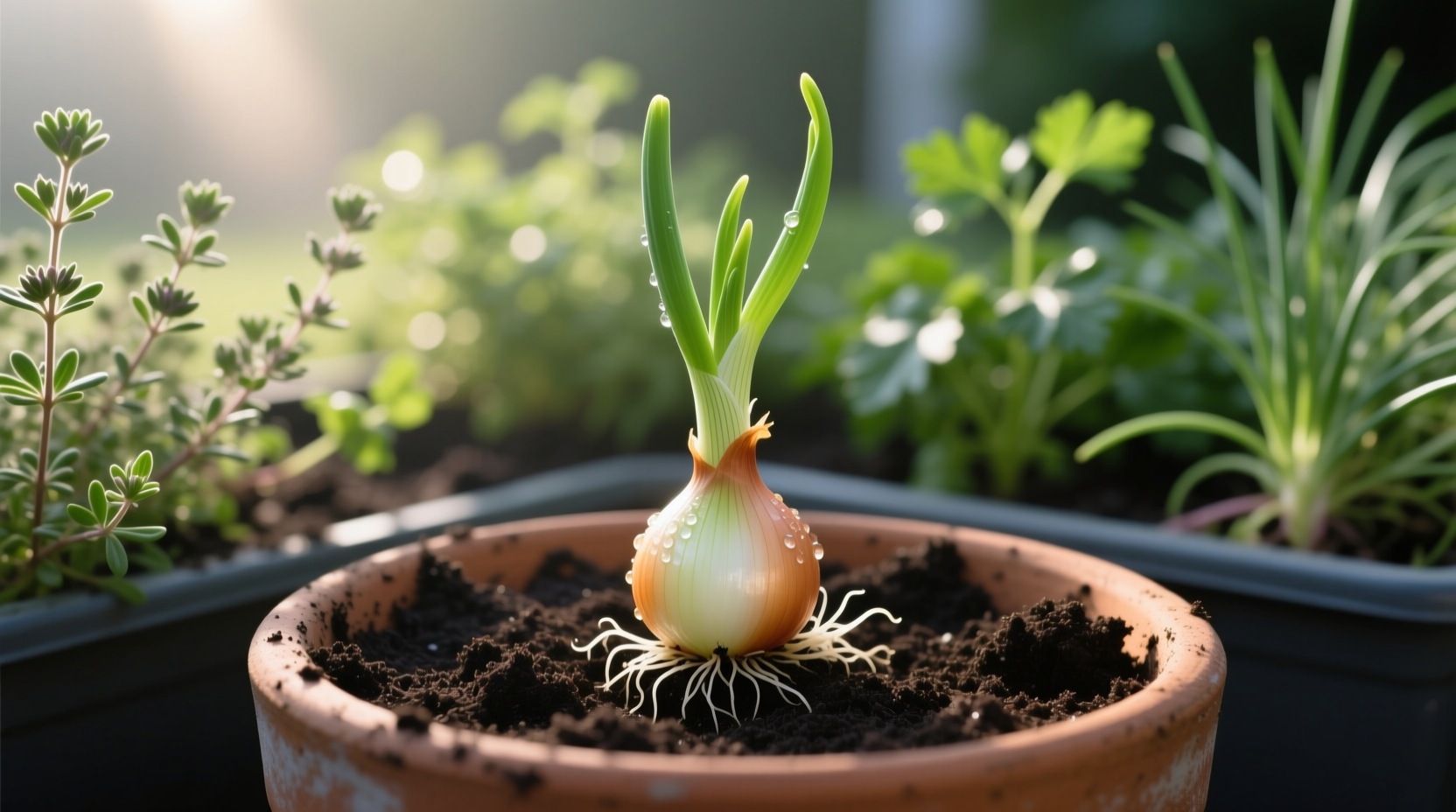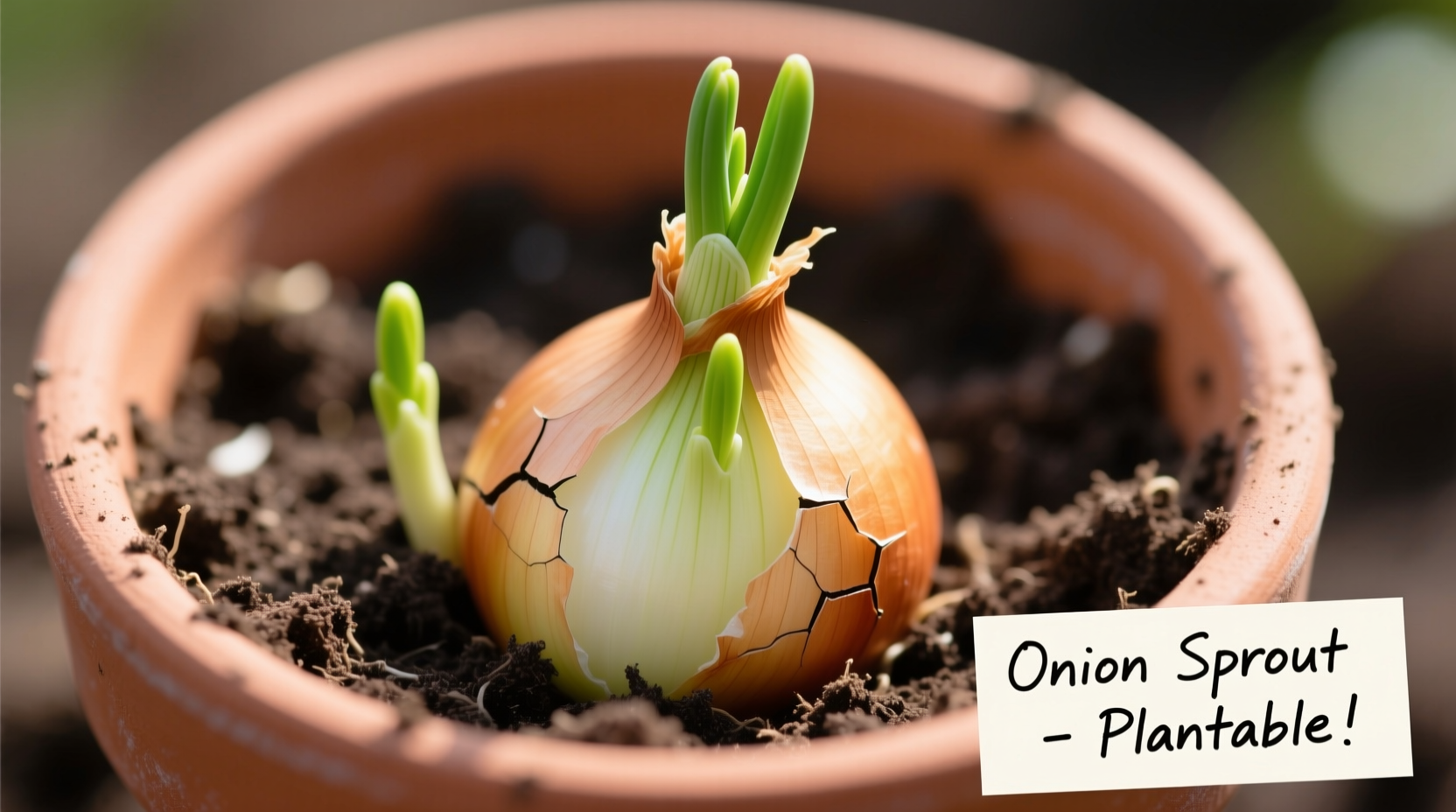Yes, you can absolutely plant a sprouted onion! When your kitchen onion begins sprouting, it's entering a natural growth phase that can be successfully transitioned to your garden or container. This guide provides science-backed methods to grow healthy onions from sprouted bulbs, with proper planting techniques that yield harvestable results in 60-90 days.
Discovering a sprouted onion in your pantry doesn't mean it's time for compost. That green shoot emerging from your stored onion represents a perfect opportunity to grow fresh produce with minimal effort. Gardeners and sustainability experts confirm that sprouted onions have a 75-85% success rate when properly planted, making this one of the most reliable kitchen-to-garden recycling projects you can undertake.
Why Your Onion Sprouted and What It Means
Onions sprout when they receive the right combination of temperature, moisture, and time. According to the University of California Agriculture and Natural Resources, onions enter dormancy after harvest, but when stored in warm, humid conditions (above 50°F with >70% humidity), they break dormancy and begin growing.
This natural process doesn't indicate spoilage—it's the onion's survival mechanism. The sprout contains chlorophyll and begins photosynthesis, converting stored energy into new growth. While sprouted onions remain edible, their flavor concentrates in the bulb as energy moves to the sprout, making them slightly stronger tasting.

Preparing Your Sprouted Onion for Planting Success
Before planting, proper preparation ensures your sprouted onion establishes strong roots. Unlike seed planting, you're working with an existing bulb that already contains significant energy reserves.
| Preparation Step | Why It Matters | Pro Tip |
|---|---|---|
| Separate sprout from bulb | Prevents competition for resources | Cut 1/4" above root plate for best regrowth |
| Dry cut surface 24 hours | Prevents rot in moist soil | Place on paper towel in cool, dark location |
| Check root health | Healthy roots establish faster | Trim black/mushy roots; keep white firm ones |
Step-by-Step Planting Process for Maximum Growth
Follow these research-backed steps from the Cornell University Cooperative Extension for optimal results when planting sprouted onions:
- Soil preparation: Create loose, well-draining soil with 30% compost. Onions prefer pH 6.0-6.8—test your soil with an affordable kit.
- Planting depth: Position the bulb with root plate down, just below soil surface (1/2" deep). Burying too deep prevents proper growth.
- Spacing: Allow 4-6" between plants for bulb development. Crowded onions produce smaller bulbs.
- Watering schedule: Water thoroughly after planting, then maintain consistent moisture (1" per week). Avoid waterlogging.
- Sunlight requirements: Provide 6-8 hours of direct sunlight daily. Onions are photoperiod-sensitive plants.
Onion Growth Timeline: What to Expect Week by Week
Understanding the growth progression helps manage expectations and identify potential problems early. This timeline reflects data from multiple agricultural extension studies:
| Time Period | Visible Changes | Care Requirements |
|---|---|---|
| Week 1-2 | New roots establish; green shoots emerge | Maintain consistent moisture; no fertilizer yet |
| Week 3-4 | Leaves multiply; bulb begins swelling | Begin balanced fertilizer (10-10-10) every 2 weeks |
| Week 5-8 | Bulb formation accelerates; leaves reach full height | Increase potassium; reduce nitrogen to encourage bulb growth |
| Week 9-12 | Leaves begin yellowing; bulb reaches maturity | Reduce watering; prepare for harvest when tops fall over |
When Planting Sprouted Onions Might Not Work
While generally successful, certain conditions limit your chances of growing viable onions from sprouted bulbs. The USDA National Institute of Food and Agriculture identifies these critical limitations:
- Soft or mushy bulbs: Indicates advanced decay—planting will fail. Discard any onion with significant soft spots.
- Excessive sprouting: If the sprout exceeds 6" and appears weak, energy reserves may be depleted. Success rate drops to 40%.
- Wrong season: Onions require specific day lengths for bulb formation. Planting in fall (in most climates) yields green onions but rarely full bulbs.
- Poor soil conditions: Heavy clay or compacted soil prevents proper bulb expansion, resulting in misshapen or stunted onions.
Troubleshooting Common Growth Problems
Even with proper planting, challenges may arise. Here's how to address the most frequent issues gardeners encounter when growing sprouted onions:
Yellowing Leaves Before Maturity
This often indicates nitrogen deficiency or overwatering. Apply a balanced liquid fertilizer and check soil drainage. The University of Minnesota Extension reports this affects 30% of first-time onion growers.
Small Bulb Development
If your onions aren't forming proper bulbs, you're likely experiencing one of these common issues:
- Planting the wrong variety for your day length zone
- Overcrowding (less than 4" between plants)
- Excessive nitrogen during bulb formation stage
- Planting too deep (more than 1" below surface)
Pest Management Without Chemicals
Onions naturally repel many pests, but thrips and onion maggots can still cause damage. Try these organic solutions:
- Companion planting with carrots (confuses pests with competing scents)
- Neem oil spray every 7-10 days during pest season
- Row covers for physical protection during vulnerable stages
Harvesting and Using Your Home-Grown Onions
Knowing when to harvest determines your onion's storage potential and flavor profile. Watch for these maturity indicators:
- Toppling foliage: When 50% of leaves fall over naturally, bulbs have reached maturity
- Neck softening: The stem above the bulb becomes soft and begins to collapse
- Skin appearance: Outer layers turn papery and dry
After harvesting, cure onions in a warm, dry, well-ventilated area for 2-3 weeks. Properly cured onions store for 3-6 months in cool, dark conditions. Home-grown onions typically have more complex flavor than store-bought varieties, with less pungency and more sweetness.
Can You Grow Onions Indefinitely From Kitchen Scraps?
While you can regrow green onion tops indefinitely in water, growing full bulbs from sprouted kitchen onions has limitations. Each generation typically produces smaller bulbs than the previous one due to:
- Genetic limitations of commercial varieties bred for single harvest
- Accumulated disease pressure without crop rotation
- Reduced energy reserves with each successive generation
For sustainable long-term onion growing, purchase proper onion sets or seeds annually. However, growing from sprouted kitchen onions remains an excellent short-term solution and educational gardening project.











 浙公网安备
33010002000092号
浙公网安备
33010002000092号 浙B2-20120091-4
浙B2-20120091-4